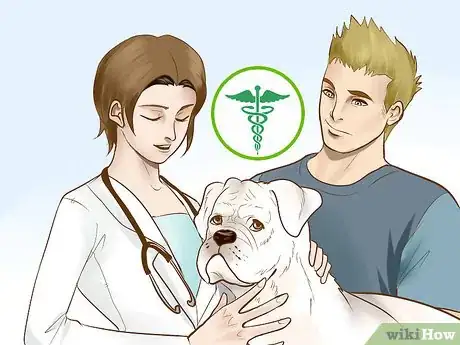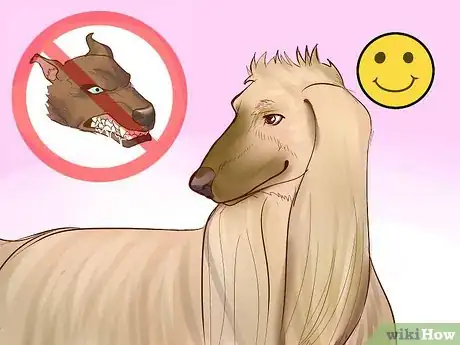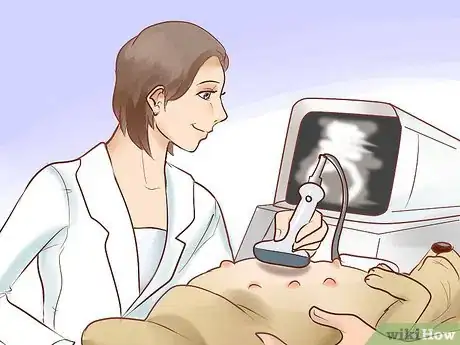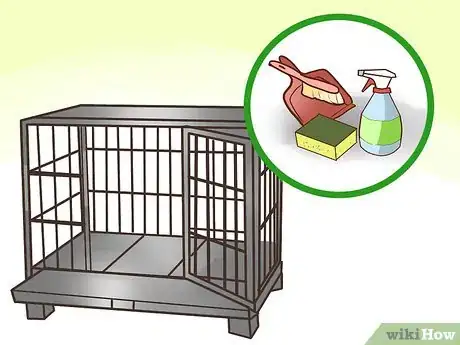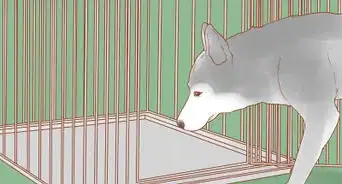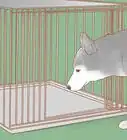This article was co-authored by Tom Robertson. Tom Robertson is a Dog Breeding Specialist and the Owner of Prize Poodles and Doodles. With over 20 years of experience, he specializes in breeding doodles. Tom has also received additional educational training in dog grooming, boarding, and training.
There are 12 references cited in this article, which can be found at the bottom of the page.
This article has been viewed 20,704 times.
One of the challenges of breeding dogs is making sure you do so responsibly. Responsible breeders are serious about improving the status of the breed. In addition, responsible breeders care for the dogs they breed and raise. Ultimately, a responsible dog breeding program is one that recognizes that dogs are living, feeling animals, and that the breed they are propagating has unique characteristics that are worth preserving. By breeding responsibly, maintaining health and cleanliness in your operation, and picking healthy breeding stock, you'll be able to establish a solid breeding program.[1]
Steps
Creating a Plan for Your Business
-
1Visit other breeders. The best way to prepare yourself for a breeding program is to visit and learn from other breeders. Breeders who have been in the business for many years will have a lot of experience they can share with you.
- Contact your local kennel club for the names of breeders who are interested in mentoring new breeders.
- Call breeders you've met before and ask if they will allow you to tour their facilities. For instance, say "Hi John, we met a few years ago. I'm interested in breeding Yorkshire terriers, and I was wondering if I could take a look at your facilities and maybe ask you a few questions."
- It is important that other breeders recognize you want to establish a responsible program. When talking to them, include that language. For instance, say "I want to start a responsible breeding program committed to bettering the breed and producing healthy and well-adjusted dogs."
- Unless you are acquainted with the breeder, avoid contacting people who focus on the same breed you intend to breed. They might see you as competition.[2]
-
2Design a business plan. A business plan will provide you with the opportunity to research many aspects of the dog breeding business. As a result of this research, you'll be able to compile all of the relevant information you'll need into one document. In the end, this will help you decide whether dog breeding -- and your specific plan -- is viable.
- Choose a breed and research it.
- Investigate laws and regulations concerning dog breeding in your region. For instance, call your local animal control officer or the police department.
- Research the climate and competition for the breed you are interested in breeding. Take a look at local shelters to see if there is an excess of those dogs. In addition, do an internet search to see if there are many breeders in your area that focus on the same breed.
- Estimate the amount of money you'll need to start your business. Include facilities (cages, yard space, and more), reserve money for vet bills, reserve money for food, and money for permits and related expenses.
- Make sure your insurance will cover you, or see if you can get a small business owner's insurance policy for your new business.
- Calculate how much money and how long it would take for you to break even on your expenses given responsible breeding practices.[3]
Advertisement -
3Find the right facilities. After you've written your business plan, you need to begin the search for facilities to house your breeding program. In the end, the facilities will depend on the scale of your operation, your existing situation, and the region in which you live.
- Make sure you have plenty of space. For instance, depending on the breed you pick, you'll likely need large indoor and outdoor runs for the dogs.
- Based on your prior research, make sure the location you are going to pick is zoned properly and meets local ordinances. For instance, you may not be able to have a commercial breeding program in a suburban neighborhood.
- Locate or be prepared to construct fenced-in runs or other structures. It may be possible for you to convert existing builders. For instance, you may be able to repurpose a barn or old chicken house.
- Make sure your facilities are structurally sound and meet kennel club and Humane Society guidelines for the treatment of animals.
Picking Healthy Breeding Stock
-
1Investigate the dogs' pedigree. Spend some time to learn about the history of your breeding stock's bloodline. Knowing about your dog's pedigree will help make sure your stock is the best, is healthy, and that your puppies will be attractive adoptees.
- If possible, ascertain registration paperwork from a naturally or internationally recognized kennel club or association verifying the pedigree of your dogs. This will also improve the marketability of any puppies your breeding stock produces. Examples of kennel clubs in the United States include the American Kennel Club and the United Kennel Club.
- Consider having genetic testing done to verify the pedigree of your breeding stock DNA testing will confirm pure bread status or inform you of the different breeds your dogs are descended from.
-
2Avoid breeding dogs with inherited medical problems. One of the biggest mistakes that breeders make is to perpetuate certain disorders and congenital medical problems. Responsible breeders make sure to use only the healthiest dogs.
- Never breed dogs with conditions that might be inherited. For instance, white boxers that are deaf, or pugs that develop hip dysplasia early in life.
- If you don't know the medical history of a dog, either don't breed it or contact people who owned the dog's parents or grandparents.
- Consult a veterinarian if you have questions about a dog's medical condition.[4]
-
3Pick dogs with good temperament. The best breeding dogs are dogs with good temperaments that reflect breed-based behavioral standards.[5] Dogs that don't reflect these standards, or exhibit an aggressive temperament, should never be bred.
- For example, per the American Kennel Club, the Afghan hound's personality characteristics are independent, silly, and sweet. Dogs without these characteristics should not be bread.
- Any dogs that demonstrate aggression to other dogs or humans should never be bred.[6]
Breeding Responsibly
-
1Learn about the mating process. Whether you are an experienced breeder or a novice, there are some basics about the mating process you need to review before creating a responsible breeding program.
- Dogs can start mating between 12 months and 24 months. The exact time depends on the breed and size of the dog. Consult your vet or kennel club for more information.
- Female dogs go into heat -- the period in which they can conceive -- between 1 and 4 times every year.
- The heating cycle lasts about 21 days.
- Many breeders recognize the 9th or 10th day of heat as the best time for conception.
- Pair the male and female on days 9, 11, and 13 of the female's cycle for the best chance at conception.[7]
-
2Stay focused on the well-being of your dog. As the center of your breeding program, your dogs should be treated well and have good living conditions.[8] Without good treatment and living conditions, they may develop problems that interfere with pregnancy. In addition, the moral and ethical imperatives of dog breeding demand you to treat dogs in a humane manner.
- Provide good living conditions for your breeding stock.[9] For instance, if your dogs are pets, you should provide them large indoor-outdoor runs and the ability to access open spaces and run freely during a substantial part of the day.
- Never breed a dog when she is too young or old. For most breeds, female dogs should not be bred before age 2 or after age 5.
- Provide enough time between pregnancies for the dog to recover. Always wait at least one heat for recuperation between pregnancies.[10]
-
3Select the best possible homes for your dogs. Invest serious time and energy into picking good and responsible caretakers for your puppies. Ultimately, a responsible breeder is one who is serious about placing their dogs in good homes.
- Interview prospective owners. Ask questions about who will be primary care taker, why they want a certain breed, and if they have enough money to pay for food and vet costs.
- Schedule a home visit. Check to see if they have a fenced-in yard, if there are apparent dangers in the home, and if there are other pets present.
- Ask for personal and professional references. Prospective owners may submit personal references from friends and family, and professional references from veterinarians and other breeders.
-
4Do not overbreed. Over breeding for profit is one of the hallmarks of irresponsible breeding programs.[11] Overbreeding not only increases the population of dogs that need homes, but may result in lower prices and decreased ability to select only the best homes for your dogs. Make sure to:
- Never breed more dogs than you can responsibly care for.
- Avoid breeding dogs that that are in overabundance in your area. For instance, if dog shelters and rescue groups have dozens of boxers or treeing walker coonhounds, as a pet lover and a responsible breeder, you should not breed anymore.[12]
-
5Socialize your puppies. Devote time early on to making sure the puppies are socialized properly.[13] By socializing the puppies, you'll be working to make sure they can adjust to their new homes.
- After the puppies have had their first vaccines, expose them to other animals. For instance, introduce them to a tame older cat or dog.
- Make sure the puppies meet a lot of different people, including children. However, make sure to supervise all interaction between the puppies and children.
- When appropriate, take the puppies for a walk or somewhere else outside the house. Getting the puppies used to new environments will ease their transition when they find their forever home.[14]
Maintaining Health and Cleanliness
-
1Immunize your dogs. Perhaps the most important thing to do, health wise, is to immunize your dogs regularly. Immunizations are important not just for your bitch and stud, but for the puppies as well.
- Your breeding stock – male and female dogs you will mate – should always be up to date on all standard vaccinations. This includes annual and semiannual leptospirosis, distemper, rabies, and bordetella vaccines.
- Newborn puppies should have their first round of puppy shots at 6 weeks, their second round at 9 weeks, and their third at 12 weeks.
- Common puppy vaccinations include hepatitis, canine distemper, parvovirus, parainfluenza, adenovirus cough, and leptospirosis.[15]
-
2Provide regular veterinarian care for your dogs. Health care is the most important aspect of maintaining a healthy breeding program. Without regular vet care, you'll jeopardize the health and well-being of your mating dogs and puppies.
- Take your dogs to the vet every annually or biannually.
- Have your pregnant bitches see the vet as often as needed. Make sure to have your vet perform diagnostics like ultrasounds to verify that pregnancy is proceeding normally.[16]
-
3Clean your cages and facilities. One of the major problems associated with large scale breeding programs is lack of cleanliness.[17] An unclean and unsanitary environment can endanger your puppies. In addition, potential clients will be turned off if they view an unsanitary facility.
- Remove fecal matter and urine from any enclosures or runs.
- Use appropriate disinfectant and use it correctly. For instance, when using bleach, make sure to water it down to one part bleach and thirty-two parts water.
- Wash blankets, toys, and other items when they are dirty.
- Bathe mature dogs once a month and bathe puppies as needed.[18]
Community Q&A
-
QuestionTo socialize pups do I also use other animals like cats, etc.? And is there a special brand of food that will help the puppies grow strong and healthy?
 Community AnswerYes, you should use other animals. It would help them get used to other animals if they were adopted into a house with other animals. I recommend using a grain-free food, such as Fromms Heartland Gold. My puppy loves it and it keeps her very happy and healthy. Grain-free food also can help get rid of allergies in dogs.
Community AnswerYes, you should use other animals. It would help them get used to other animals if they were adopted into a house with other animals. I recommend using a grain-free food, such as Fromms Heartland Gold. My puppy loves it and it keeps her very happy and healthy. Grain-free food also can help get rid of allergies in dogs. -
QuestionCan I use a brother and sister for breeding?
 Community AnswerNo! Do not breed siblings or even family members. Their puppies will likely be born with defects.
Community AnswerNo! Do not breed siblings or even family members. Their puppies will likely be born with defects.
References
- ↑ Tom Robertson. Dog Breeding Specialist. Expert Interview. 5 April 2022.
- ↑ http://www.akc.org/akc-dog-lovers/a-mentor-to-help-you-learn-more-about-dogs/#
- ↑ https://www.profitableventure.com/starting-a-dog-breeding-business/
- ↑ http://www.instituteofcaninebiology.org/blog/health-of-purebred-vs-mixed-breed-dogs-the-data
- ↑ Tom Robertson. Dog Breeding Specialist. Expert Interview. 5 April 2022.
- ↑ http://www.akc.org/dog-breeds/
- ↑ https://pethelpful.com/dogs/Dog-Mating
- ↑ Tom Robertson. Dog Breeding Specialist. Expert Interview. 5 April 2022.
- ↑ Tom Robertson. Dog Breeding Specialist. Expert Interview. 5 April 2022.
- ↑ http://www.akc.org/dog-breeders/responsible-breeding/
- ↑ Tom Robertson. Dog Breeding Specialist. Expert Interview. 5 April 2022.
- ↑ https://www.paws.org/get-involved/take-action/explore-the-issues/puppy-mills/
- ↑ Tom Robertson. Dog Breeding Specialist. Expert Interview. 5 April 2022.
- ↑ http://www.akc.org/content/dog-training/articles/puppy-socialization/
- ↑ http://www.akc.org/content/health/articles/puppy-shots-complete-guide/
- ↑ http://www.akc.org/content/dog-breeding/articles/the-care-and-feeding-of-the-breeding-bitch-part-one/
- ↑ Tom Robertson. Dog Breeding Specialist. Expert Interview. 5 April 2022.
- ↑ http://www.akc.org/content/dog-care/articles/bathing-puppy-bath-shampoo-care/
About This Article
Once you've chosen a breed, research it as much as possible so you understand its individual needs. Then, look online to find puppies of your chosen breed and make sure there isn’t too much competition in your area. You should also investigate the bloodlines of the individual dogs you want to breed to make sure your puppies will have strong and healthy genetics. You’ll also need to write a budget to ensure you have the funds to cover facilities, insurance, and veterinary fees. Look for facilities with large indoor and outdoor areas so your dogs aren’t cooped up. Once you've got the facilities set up and a strong business plan, you can buy the dogs from a reputable owner. When you breed your dogs, allow at least one heat cycle between each mother's pregnancies so they have time to recover. For more tips, including how to choose a healthy and profitable breed, read on!





